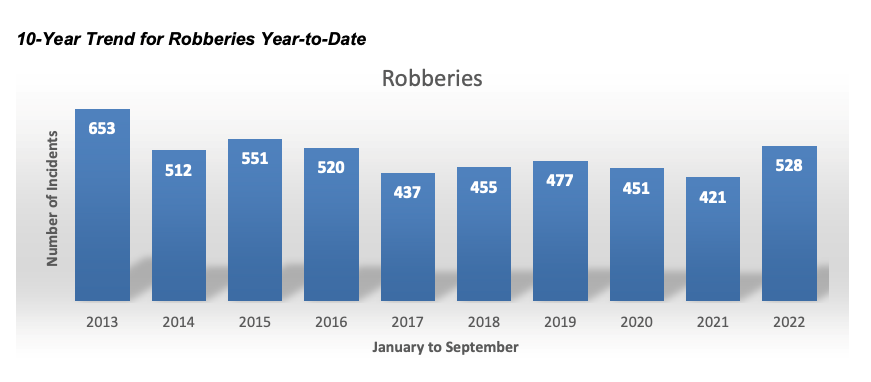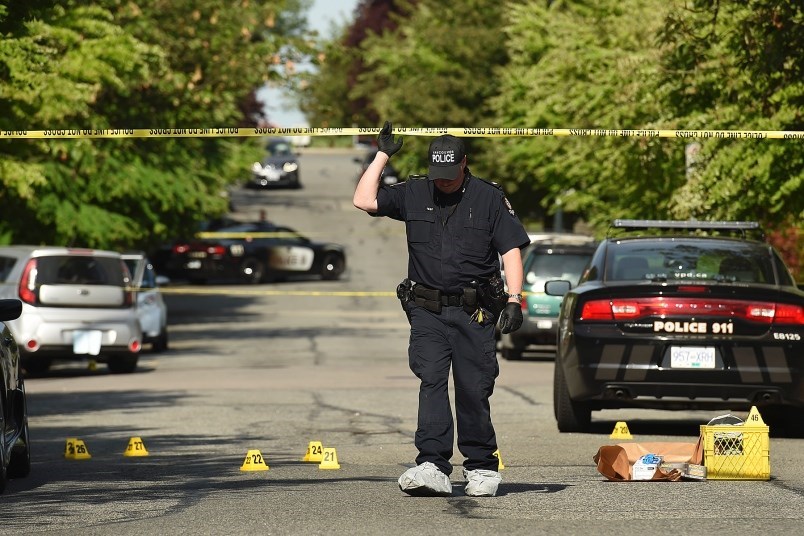The number of robberies in Vancouver that occurred over nine months this year — 528 — have increased significantly over the past five years and are on pace to equal or surpass the 755 heists recorded for the entire year in 2015.
Data from the Vancouver Police Department (VPD) that compares robbery statistics from January to September of each year going back to 2013 shows an average of 460 robberies between 2016 and 2021.
The 528 this year pushes Vancouver back to 2016 and 2015 levels when robberies for the first nine months of the year totalled 520 and 551, respectively. Vancouver’s highest number of robberies over the past 10 years for the nine-month period occurred in 2013, with 653 recorded.
Robberies totalled 848 by year end in 2013.
Some recent robberies this year include:
• On Oct. 6, police arrested a bank robbery suspect who barricaded himself in a taxi for nearly two hours after he attempted to rob a bank near Main and East Pender streets in Chinatown.
Officers stopped the taxi near Main Street and National Avenue, allowing the driver and a second passenger to flee. A VPD emergency response team, a police dog and a Taser were used to arrest the man.
• On Sept. 30, two people robbed a Howe Street boutique of clothing by spraying two employees with bear spray.
A woman in her 30s, wearing all black and a surgical mask to cover her face, entered the store and started browsing at clothing and accessories. She selected a purse and briefly posed in a mirror.
While employees were distracted, a male accomplice entered the store. When the woman tried to leave without paying, the man sprayed the staff in the face, grabbed clothing off the rack, then ran out.
• Also in September, police issued a warning to anyone trying to sell or trade merchandise online to take precautions when meeting in person, after a series of violent robberies in Champlain Heights and Kerrisdale.
In one incident in Kerrisdale, a man pulled a gun inside a coffee shop after convincing someone to meet him there to buy a used designer watch.
Police said each of the robberies occurred in a public place and involved someone trying to sell used merchandise on Facebook Marketplace.

'Noticeable increase in violence'
A report to the Vancouver Police Board last month highlighted the upward trend in robberies and pointed to a recent B.C. government-commissioned report to help explain the increase in heists and violent behaviour.
The Rapid Investigation into Repeat Offending and Random Stranger Violence in British Columbia was authored by academic researcher Dr. Amanda Butler and former Vancouver deputy chief Doug LePard.
The authors interviewed police, mayors, city officials, street nurses, Vancouver Downtown Community Court staff and others who described thefts from businesses and street crime and disorder “increasing dramatically, with a noticeable increase in violence and confrontational and threatening behaviour.”
'Bladed and blunt weapons'
A written submission to the authors from the Retail Council of Canada said staff at stores have been assaulted and threatened repeatedly.
“We are also seeing increasing use of noxious substances, bladed and blunt weapons and firearms in store robberies, and recent, but alarming incidences of arson, jeopardizing the lives and health of customers and store employees alike,” the council wrote.
For example, the council continued, some retailers shared that from 2019 to 2021 they saw an increase of between 150 to 200 per cent in violence and aggravated offences against frontline staff, security guards and customers.
“Members have also seen an alarming increase in the use of weapons ranging from bear spray and knives to guns,” the council said.
For their investigation, Butler and LePard conducted a focus group of major retail chains such as London Drugs, Walmart, Nordstrom, Sobeys, Value Village, Circle K/Mac’s Convenience and others.
The representatives were united in describing that the current situation of escalating thefts and violence was the worst it had ever been, with some representatives having 30 years’ experience in business.

Security guards increase from 22 to 322
A representative for Value Village described having to make huge expenditures for “tactical security” to deal with prolific thefts, as well as break-ins and arsons.
Another described having to increase from 22 uniformed guards at stores in Western Canada to 322, with half of them in B.C., where the top seven problem stores are located.
“Many representatives described the challenge of attracting and retaining staff — often young people — because of the constant threatening behaviour,” the authors wrote.
“They described how they used to be focused on preventing shoplifting and now they are focused simply on keeping their staff safe because of the increasing presence of weapons such as knives, bear spray and replica firearms.”
Security staff have been attacked and clerks spat on and victimized by verbal and sometimes racist abuse. Some retailers described having difficulty staying in markets like Vancouver and Victoria due to the difficulty in keeping staff because of the violence.
“They also reported that because of the lack of substantive charges and charges for breach of conditions, unless there is violence, they simply do not report thefts to the police because of the lack of consequences,” the report from Butler and LePard said.
“They also reported that thefts with violence which in years past would result in a robbery charge are now simply treated as shoplifting by the courts.”
A London Drugs representative reported there were 24 cases of assaults on staff in 2017 and that increased to 99 in 2019, “and that in the previous 30 days in 2022, there had been 56 cases involving violence.”
Retailers are aware the crime is connected to complex factors, including an increase in homelessness, substance use and mental health issues. But they also noted people involved in repeat crime were “emboldened by a sense that there would be no consequences for their escalating behaviour,” the report said.
'We get the problem when everyone else has failed'
Peter Juk, B.C.’s deputy attorney general, told Butler and LePard that police, Crown and the courts are “at the end of a long stream” when it comes to dealing with repeat offenders.
“What they’ve done upstream is beyond our control, when everything else has failed: mental health care, schooling, housing, etc., what’s needed to be a functioning member of society,” said Juk, a former prosecutor.
“So we get the problem when everyone else has failed, and we don’t have access to alternative measures or off-ramps for these offenders.”
In summarizing what is needed for long-term reductions in crime, Butler and LePard recommended the B.C. government “invest significantly in addressing the systems-level issues that contribute to offending including systemic racism, poverty, inadequate health services, food insecurity and housing unaffordability.”




